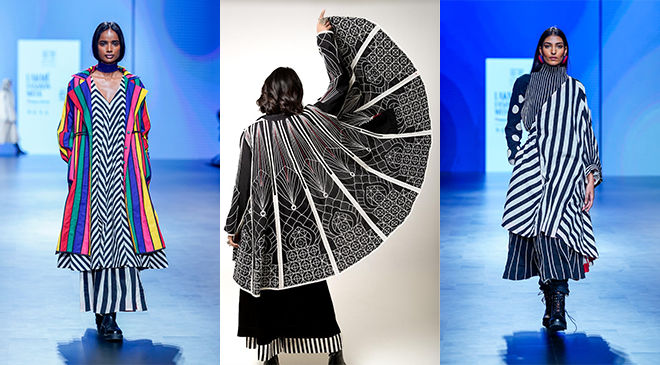
Karishma Shahani
Founder
Label - Ka-Sha
People should embrace the idea of re-sale of pre-loved purchases
Ka-Sha sees clothing as a canvas for celebrating handcrafts, embodying a tribute to life's richness and diverse surroundings. Motivated by both ancient and contemporary artisanal techniques, Ka-Sha's creations draw inspiration from people, stories, journeys, and perspectives. In an interview with Fibre2Fashion, Founder Karishma Shahani sheds light on her decision to focus on ethical fashion, emphasising how collaborations contribute to conscious fashion, and discusses the impact of education on artisans and workers.
Fibre2Fashion: What inspired you to establish a brand with a focus on conscious fashion, and what obstacles did you encounter in the early stages?
Karishma Shahani:
With Ka-Sha, we simply wanted to create products that are built with an awareness of their origin as well as journey. It is a culmination of Indian crafts and techniques, and our inherent culture of reusing/recycling across generations. These ideologies lie at the core of the brand and have shaped the way we function at Ka-Sha.
F2F: Your approach to sustainable fashion is described as ‘conscious’ rather than ‘sustainable’. Could you elaborate on what conscious fashion means to you and how it differs from the widely used term ‘sustainable’?
KS:
The term ‘sustainable’ has, over time, become an overused and vague term to describe clothing and practices in the industry. It has many connotations. While the word itself denotes the ability to maintain or support a process over time, its usage tends to prioritise the tangible aspects of a product. As a concept, it should cover environmental, economic, and social connotations of the industry, considering questions like: Are people being treated fairly? Does the design process allow us to create responsibly? Is the environment of the maker in tandem with the experience of the customer? Hence, I find the word ‘conscious’ to be a more expansive adjective to describe how we create what we do.
F2F: How has your background and family values influenced your decision to focus on crafts and ethical fashion?
KS:
A part of my family wore a lot of handwoven textiles—a conscious decision they made while dreaming of an independent India, and one that persisted as their preferred way of dressing as we grew up. Ironically, I never realised the significance of this tradition. It was only after starting my fashion education, through conversations, research, and travel, that I began to draw parallels between what I had always taken for granted and an understanding of its power.
F2F: Could you shed light on your design philosophy and the cultural influences that inspire your creations?
KS:
Our design philosophy thrives on personal perspectives of things around us: stories, conversations, culture, mythology, books, music, colours— the list is endless. Personally, I love engaging with topics (some familiar and others new) to translate them into clothing. Many times, they are older inspirations revisited with a fresh point of view, reflecting our own evolution and learning. I am fascinated by the correlation between history, societal commitments, current affairs, and clothing, and I believe this is what guides our philosophy and influences.
F2F: Your commitment to education is evident in your workshops. How do you believe education can influence artisans and workers to value sustainability?
KS:
The commitment to education extends to all stakeholders—both the maker and the consumer—making them equal participants in this conversation. It aims to provide exposure to the maker, allowing them to see new perspectives that can enhance their existing skills. Simultaneously, it is an opportunity for the customer to acquire new skills through skill-sharing, fostering an appreciation for the time, effort, and skill required to create even the simplest products when undertaking the process themselves.
F2F: Ka-Sha is known for collaborating with various clusters, NGOs, and artisans. How do these collaborations contribute to your vision of conscious fashion?
KS:
I think it’s a two-way street. Design and craft should go hand in hand to be able to improve future opportunities. These collaborations help us learn more about the practices of the creators and allow us the opportunity to share ours. Such interactions help both the parties to evolve together, contributing to the development within this creative dynamic.
F2F: Ka-Sha incorporates upcycling and waste management into its practices. Can you provide examples of how the label uses recycled or repurposed materials in its designs?
KS:
Since our inception in 2012, we have been upcycling our post-production waste, through our sister-label ‘Heart to Haat’. Here, you will find products that are made entirely from waste. We use traditional skills of sewing, embroidery, crochet, and weaving to create clothing, home textiles, and lifestyle accessories. We also offer after-care services for Ka-Sha purchases which focus on repair and refurbishing.
F2F: Ka-Sha has participated in major fashion shows globally. How do you perceive the role of your label in the global fashion landscape?
KS:
With a commitment to innovation and modern outlook, we aim to offer a new interpretation that goes beyond the conventional, thus, reshaping the narrative of Indian fashion globally.
F2F: Do you have any advice for emerging designers or fashion houses looking to adopt more sustainable and conscious practices?
KS:
I think sometimes people get very caught up in the sheer volume of activities that are deemed as sustainable, which can be very intimidating. Starting somewhere is the key, as claiming to be 100 per cent sustainable can be challenging for many of us. The focus should be on assessing possibilities and achieving them by prioritising based on factors that are personal to you, which include location, surroundings, pressing needs, and opportunities. The key should be to set realistic goals and keep moving along, achieving them to a point that they become so streamlined with your design process where it becomes second nature. The deeper the value and the more self-sustaining the practices become, the more meaningful and impactful they are.
F2F: In your opinion, what changes are needed in the broader fashion industry to make sustainable and conscious practices more mainstream and impactful?
KS:
Greenwashing needs to stop. Sustainability shouldn’t be practiced for the sake of it or be used as a marketing element. It shouldn’t be viewed as a trend. Stereotypes related to the term need to be broken. The tangible elements aren’t the only thing that should be certified as sustainable.
F2F: How can consumers contribute to the shift towards conscious fashion in their everyday choices?
KS:
I think people can start by embracing the idea of re-sale of pre-loved purchases—it’s a great start to move things that you don’t wear. Consider disposal/letting go of the products as seriously as you think about purchasing the products.
F2F: How do you see your brand evolving and contributing to a more sustainable and conscious fashion industry in the coming years?
KS:
We aim to make small yet meaningful changes as we continue to learn. This involves creating a safe space for our makers and ensuring livelihood opportunities through more robust design processes.

Gabi Seligsohn
Pradip Mehta
Aseem Prakash
Abhay Gupta
Bill D’Arienzo
Rahul Mehta
Rahul Mehta
Fanny Vermandel
Anurag Batra
Arun Sirdeshmukh


20230103183907.png)





_8.JPG)




